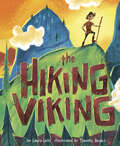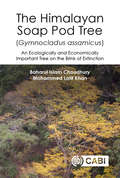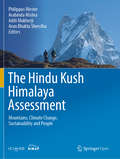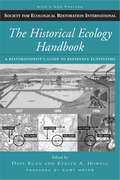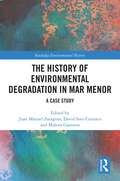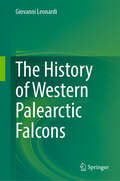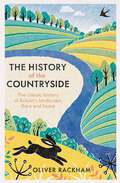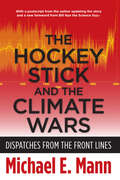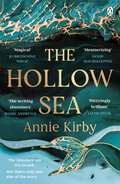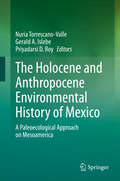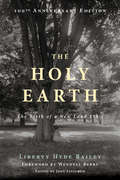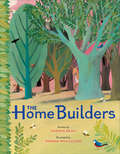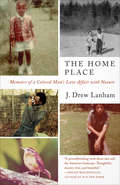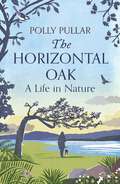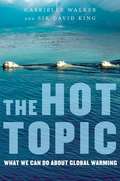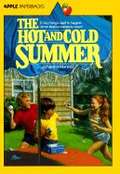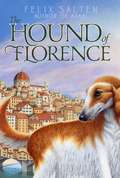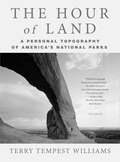- Table View
- List View
The Hiking Viking
by Laura GehlWhile the other Vikings love to holler and howl and battle and brawl, Leif prefers spending time by himself atop the beautiful fjord. But when it’s time for the Viking Games, everyone must participate. Will Leif let down his clan . . . or surprise them? Highlighting the value of nature and earthly wonders, best-selling author Laura Gehl teams up with illustrator Timothy Banks to remind readers to stay true to themselves and to look at things from a new perspective.
The Himalayan Soap Pod Tree (Gymnocladus assamicus): An Ecologically and Economically Important Tree on the Brink of Extinction
by Dr Baharul I Choudhury Professor Mohammed Latif KhanExtinction of species has alarmingly increased in recent decades due to anthropogenic activities, natural calamities and climate change. The life history, ecology and evolution of such species have often not been well studied. Gymnocladus assamicus is an archaic tree endemic to the Eastern Himalayan region of Northeast India. Locally known as 'Menangmanba-shi' by the Monpa tribe of Arunachal Pradesh (India), mature G. assamicus pods contain high saponin and are used traditionally for cleansing purposes and rituals. We rediscovered the species after more than 70 years from high altitude areas in the Himalayas through extensive field explorations and employing an ecological niche modeling approach. Our study revealed a very few actively reproducing mature G. assamicus trees surviving in unique microclimatic conditions. The species is classified as 'critically endangered' (IUCN red list). The book contains detailed information about G. assamicus and discusses its current distribution, population status, ethnobotanical uses and other ecological parameters. Major intrinsic and extrinsic factors that might be responsible for population decline are described. More importantly, we reported a very rare mating system known as 'androdioecy' in which male and hermaphrodite individuals co-exist in the natural population. Overall, the book highlights the story of a critically endangered tree species with a unique biological and socio-cultural importance and will serve as a case study and referencefor other similar species both locally and globally.
The Hindu Kush Himalaya Assessment: Mountains, Climate Change, Sustainability and People
by Philippus Wester Arabinda Mishra Aditi Mukherji Arun Bhakta ShresthaThis open access volume is the first comprehensive assessment of the Hindu Kush Himalaya (HKH) region. It comprises important scientific research on the social, economic, and environmental pillars of sustainable mountain development and will serve as a basis for evidence-based decision-making to safeguard the environment and advance people’s well-being. The compiled content is based on the collective knowledge of over 300 leading researchers, experts and policymakers, brought together by the Hindu Kush Himalayan Monitoring and Assessment Programme (HIMAP) under the coordination of the International Centre for Integrated Mountain Development (ICIMOD). This assessment was conducted between 2013 and 2017 as the first of a series of monitoring and assessment reports, under the guidance of the HIMAP Steering Committee: Eklabya Sharma (ICIMOD), Atiq Raman (Bangladesh), Yuba Raj Khatiwada (Nepal), Linxiu Zhang (China), Surendra Pratap Singh (India), Tandong Yao (China) and David Molden (ICIMOD and Chair of the HIMAP SC).This First HKH Assessment Report consists of 16 chapters, which comprehensively assess the current state of knowledge of the HKH region, increase the understanding of various drivers of change and their impacts, address critical data gaps and develop a set of evidence-based and actionable policy solutions and recommendations. These are linked to nine mountain priorities for the mountains and people of the HKH consistent with the Sustainable Development Goals. This book is a must-read for policy makers, academics and students interested in this important region and an essentially important resource for contributors to global assessments such as the IPCC reports.
The Historical Ecology Handbook: A Restorationist's Guide to Reference Ecosystems (Science Practice Ecological Restoration)
by Dave Egan Curt Meine Evelyn A. HowellThe Historical Ecology Handbook makes essential connections between past and future ecosystems, bringing together leading experts to offer a much-needed introduction to the field of historical ecology and its practical application by on-the-ground restorationists.Chapters present individual techniques focusing on both culturally derived evidence and biological records, with each chapter offering essential background, tools, and resources needed for using the technique in a restoration effort. The book ends with four in-depth case studies that demonstrate how various combinations of techniques have been used in restoration projects.The Historical Ecology Handbook is a unique and groundbreaking guide to determining historic reference conditions of a landscape. It offers an invaluable compendium of tools and techniques, and will be essential reading for anyone working in the field of ecological restoration.
The History of American Sailing Ships
by Howard I. ChapelleThis is the first complete history published of the development of the various types of sailing vessels and rigs in America from Colonial craft to modern racing and cruising yachts.
The History of Environmental Degradation in Mar Menor: A Case Study (Routledge Environmental History)
by Juan Manuel Zaragoza David Soto Malena CanteroThis book offers a multidisciplinary analysis of the degradation process of an ecosystem, drawing upon the Mar Menor as a case study to highlight the damage human pressure causes to the environment.All ecosystems change over time, although in some cases, this variation is more dynamic and evident. The Mar Menor is a clear example of this “ecological transition”, as it is the largest coastal lagoon in the western Mediterranean and the first ecosystem in Europe to be granted legal personhood rights. This book provides an extensive overview of the history of its environmental degradation over the past 100 years, highlighting the subsequent succession of environmental crises including phytoplankton explosions, the disappearance of large areas of submerged meadows due to eutrophication, and episodes of mass mortality of aquatic fauna. Split into three sections to reflect thematic blocks, the book begins with a comprehensive description of the Mar Menor and its marine ecosystems, emphasizing its ecological value and unique space in Spain and Europe. It discusses intensive and globalized agriculture, surrounding agro‑export, and the laws that legislate it. In the second part, the book draws on a series of cultural concepts, theoretical frameworks, and participatory arts‑based research to enrich our understanding of the environment from multiple perspectives. Finally, in the third part, the book uses analysis gathered from the Mar Menor case study to discuss wider conclusions about the ways in which we can begin to undo our damage to the environment and restore ecosystems.This book will be useful for students, academics, and researchers interested in environmental justice, environmental history and anthropology, sustainable development, and environmental studies more broadly.
The History of Global Climate Governance
by Joyeeta GuptaWhat has happened globally on the climate change issue? How have countries' positions differed over time, and why? How are problems and politics developing on an increasingly globalised planet, and can we find a solution? This book explores these questions and more, explaining the key underlying issues of the conflicts between international blocs. The negotiation history is systematically presented in five phases, demonstrating the evolution of decision-making. The book discusses the coalitions, actors and potential role of the judiciary, as well as human rights issues in addressing the climate change problem. It argues for a methodical solution through global law and constitutionalism, which could provide the quantum jump needed in addressing the problem of climate governance. This fascinating and accessible account will be a key resource for policymakers and NGOs, and also for researchers and graduate students in climate policy, geopolitics, climate change, environmental policy and law, and international relations.
The History of Western Palearctic Falcons
by Giovanni LeonardiFalcons have been exploited by humans as food source, ornamental purposes or for the falconry practices. There is a large historical literature in which falcons were often mentioned but always along broader topics (mainly ancient falconry and poetry). This book is the result of a parallel project developed during the preparation of "Behavioral Ecology of Western Palearctic falcons" (published by Springer in 2020). The main aim is to use archaeological and historical sources on falcons to delineate the past distribution and population ecology of these predators in the Western Palearctic ecozone. Ultimately, the approach to the data is aimed at defining the population dynamics of falcons over time. The relationship/conflict with human populations is also placed in this context. By putting falcons as a central subject of study, this book outlines their path in the Western Palearctic from the Pleistocene to modern ornithology.
The History of the Countryside
by Oliver RackhamFrom its earliest origins to the present day, this award-winning, beautifully written book describes the endlessly changing character of Britain's countryside.'A classic' Richard MabeyExploring the natural and man-made features of the land - fields, highways, hedgerows, fens, marshes, rivers, heaths, coasts, woods and wood pastures - he shows conclusively and unforgettably how they have developed over the centuries. In doing so, he covers a wealth of related subjects to provide a fascinating account of the sometimes subtle and sometimes radical ways in which people, fauna, flora, climate, soils and other physical conditions have played their part in the shaping of the countryside.'One thing is certain: no one would be wise to write further on our natural history, or to make films about it, without thinking very hard about what is contained in these authoritative pages' COUNTRY LIFE
The History of the Countryside: The Classic History Of Britain's Landscape, Flora And Fauna
by Dr Oliver RackhamFrom its earliest origins to the present day, this award-winning, beautifully written book describes the endlessly changing character of Britain's countryside.'A classic' Richard MabeyExploring the natural and man-made features of the land - fields, highways, hedgerows, fens, marshes, rivers, heaths, coasts, woods and wood pastures - he shows conclusively and unforgettably how they have developed over the centuries. In doing so, he covers a wealth of related subjects to provide a fascinating account of the sometimes subtle and sometimes radical ways in which people, fauna, flora, climate, soils and other physical conditions have played their part in the shaping of the countryside.'One thing is certain: no one would be wise to write further on our natural history, or to make films about it, without thinking very hard about what is contained in these authoritative pages' COUNTRY LIFE
The Hive Detectives: Chronicle of a Honey Bee Catastrophe (Scientists in the Field)
by Loree Griffin Burns Ellen HarasimowiczWithout honey bees the world would be a different place. There would be no honey, no beeswax for candles, and, worst of all, barely a fruit, nut, or vegetable to eat. So imagine beekeeper Dave Hackenburg's horror when he discovered twenty million of his charges had vanished. Those missing bees became the first casualties of a mysterious scourge that continues to plague honey bee populations today. In The Hive Detectives, Loree Griffin Burns profiles bee wranglers and bee scientists who have been working to understand colony collapse disorder, or CCD. In this dramatic and enlightening story, readers explore the lives of the fuzzy, buzzy insects and learn what might happen to us if they were gone.
The Hockey Stick and the Climate Wars
by Michael E. MannThe ongoing assault on climate science in the United States has never been more aggressive, more blatant, or more widely publicized than in the case of the Hockey Stick graph-a clear and compelling visual presentation of scientific data, put together by MichaelE. Mann and his colleagues, demonstrating that global temperatures have risen in conjunction with the increase in industrialization and the use of fossil fuels. Here was an easy-to-understand graph that, in a glance, posed a threat to major corporate energy interests and those who do their political bidding. The stakes were simply too high to ignore the Hockey Stick-and so began a relentless attack on a body of science and on the investigators whose work formed its scientific basis.The Hockey Stick achieved prominence in a 2001 UN report on climate change and quickly became a central icon in the "climate wars." The real issue has never been the graph's data but rather its implied threat to those who oppose governmental regulation and other restraints to protect the environment and planet. Mann, lead author of the original paper in which the Hockey Stick first appeared, shares the story of the science and politics behind this controversy. He reveals key figures in the oil and energy industries and the media frontgroups who do their bidding in sometimes slick, sometimes bare-knuckled ways. Mann concludes with the real story of the 2009 "Climategate" scandal, in which climate scientists' emails were hacked. This is essential reading for all who care about our planet's health andour own well-being.
The Hockey Stick and the Climate Wars: Dispatches from the Front Lines
by Michael MannThe ongoing assault on climate science in the United States has never been more aggressive, more blatant, or more widely publicized than in the case of the Hockey Stick graph—a clear and compelling visual presentation of scientific data, put together by MichaelE. Mann and his colleagues, demonstrating that global temperatures have risen in conjunction with the increase in industrialization and the use of fossil fuels. Here was an easy-to-understand graph that, in a glance, posed a threat to major corporate energy interests and those who do their political bidding. The stakes were simply too high to ignore the Hockey Stick—and so began a relentless attack on a body of science and on the investigators whose work formed its scientific basis.The Hockey Stick achieved prominence in a 2001 UN report on climate change and quickly became a central icon in the "climate wars." The real issue has never been the graph's data but rather its implied threat to those who oppose governmental regulation and other restraints to protect the environment and planet. Mann, lead author of the original paper in which the Hockey Stick first appeared, shares the story of the science and politics behind this controversy. He reveals key figures in the oil and energy industries and the media frontgroups who do their bidding in sometimes slick, sometimes bare-knuckled ways. Mann concludes with the real story of the 2009 "Climategate" scandal, in which climate scientists' emails were hacked. This is essential reading for all who care about our planet's health and our own well-being.
The Hole in the Tree
by Jean Craighead GeorgeWho will be the king of the hole in the tree? A delightful book where two children find a hole in a tree and watch as it becomes larger through the occupation of successive animals. Starting with a small beetle who begins the hole and the progression to different insects, birds and other animals. Even the two children use the hole once he gets large enough through the progression.
The Hollow Sea: The unforgettable and mesmerising debut inspired by mythology
by Annie KirbyTHE ISLANDERS SAY IT'S CURSED. BUT THAT'S ONLY ONE SIDE OF THE STORY . . .'A bold, magical story' JO BROWNING WROE, Sunday Times bestselling author of A Terrible Kindness'A majestic work of the imagination . . . I woke up thinking about it' ROSIE ANDREWS, Sunday Times bestselling author of The Leviathan'An atmospheric tale, shot through with folklore. The writing shimmers' KATE SAWYER, Costa shortlisted author of The Stranding_______They say the Hollow Sea is cursed. A wild expanse separating the remote islands of St Hía, not even the locals brave its treacherous waters.But new arrival Scottie feels a pull she can't ignore. Because behind the curse is the legend of Thordis: a woman whose story feels eerily familiar. No one knows what became of her, but Scottie believes Thordis's fate may answer questions about her own past.Despite the islanders' warnings, Scottie sets out to discover the truth. But as she dares to cross the Hollow Sea, will its secrets give her the answers she needs?Or will the past drag her under?_______'A heart-rending atmospheric novel of finding what makes one whole' Melissa Fu, author of Peach Blossom Spring'Mesmerising' Good Housekeeping'A poetic tale' Prima
The Holocene and Anthropocene Environmental History of Mexico: A Paleoecological Approach on Mesoamerica
by Nuria Torrescano-Valle Gerald A. Islebe Priyadarsi D. RoyThis book provides essential information on Mexico’s Holocene and Anthropocene climate and vegetation history. Considering the geography of Mexico – which is home to a variety of climatic and environmental conditions, from desert and tropical to high mountain climates – this book focuses on its postglacial paleoecology and paleoclimatology. Further, it analyses human intervention since the middle Holocene as a major agent of environmental change. Offering a valuable tool for understanding past climate change and its relationship with present climate change, the book is a must-read for botanists, ecologists, palaeontologists and graduate students in related fields.
The Holy Earth: The Birth of a New Land Ethic
by Wendell Berry Liberty Hyde Bailey John LinstromThe agrarian tradition runs as an undercurrent through the entire history of literature, carrying the age-old wisdom that the necessary access of independent farmers to their own land both requires the responsibility of good stewardship and provides the foundation for a thriving civilization. At the turn of the last century, when farming first began to face the most rapid and extensive series of changes that industrialization would bring, the most compelling and humane voice representing the agrarian tradition came from the botanist, farmer, philosopher, and public intellectual Liberty Hyde Bailey. In 1915, Bailey's environmental manifesto, The Holy Earth, addressed the industrialization of society by utilizing the full range of human vocabulary to assert that the earth's processes and products, because they form the governing conditions of human life, should therefore be understood not first as economic, but as divine. To grasp the extent of human responsibility for the earth, Bailey called for "a new hold" that society must take to develop a "morals of land management," which would later inspire Aldo Leopold's "land ethic" and several generations of agrarian voices. This message of responsible land stewardship has never been as timely as now.
The Home Builders
by Varsha BajajThis vibrantly illustrated picture book celebrates a variety of woodland creatures as they make their homes and prepare for their young.Welcome to a serene woodland where lots of expectant animal parents are in their "nesting" phase--that is, busy preparing safe, cozy homes for their growing families. As they dig, tunnel, gnaw, and gather, they create dens, burrows, lodges, and, of course, nests. Soon the woods are full of new little ones peeping, crawling, romping, and snuggling--and with artwork so gorgeous that it feels like an invitation into the scenery it's depicting, readers will be eager to join them in their beautiful home.
The Home Place: Memoirs of a Colored Man's Love Affair with Nature
by J. Drew Lanham&“A groundbreaking work about race and the American landscape, and a deep meditation on nature…wise and beautiful.&”—Helen Macdonald, author of H is for Hawk A Foreword Reviews Best Book of the Year and Nautilus Silver Award Winner In me, there is the red of miry clay, the brown of spring floods, the gold of ripening tobacco. All of these hues are me; I am, in the deepest sense, colored. Dating back to slavery, Edgefield County, South Carolina—a place &“easy to pass by on the way somewhere else&”—has been home to generations of Lanhams. In The Home Place, readers meet these extraordinary people, including Drew himself, who over the course of the 1970s falls in love with the natural world around him. As his passion takes flight, however, he begins to ask what it means to be &“the rare bird, the oddity.&” By turns angry, funny, elegiac, and heartbreaking, The Home Place is a meditation on nature and belonging by an ornithologist and professor of ecology, at once a deeply moving memoir and riveting exploration of the contradictions of black identity in the rural South—and in America today. &“When you&’re done with The Home Place, it won&’t be done with you. Its wonders will linger like everything luminous.&”—Star Tribune &“A lyrical story about the power of the wild…synthesizes his own family history, geography, nature, and race into a compelling argument for conservation and resilience.&”—National Geographic
The Homevoter Hypothesis: How Home Values Influence Local Government Taxation, School Finance, and Land-Use Policies
by William A. FischelJust as investors want the companies they hold equity in to do well, homeowners have a financial interest in the success of their communities. If neighborhood schools are good, if property taxes and crime rates are low, then the value of the homeowner’s principal asset—his home—will rise. Thus, as William Fischel shows, homeowners become watchful citizens of local government, not merely to improve their quality of life, but also to counteract the risk to their largest asset, a risk that cannot be diversified. Meanwhile, their vigilance promotes a municipal governance that provides services more efficiently than do the state or national government. Fischel has coined the portmanteau word “homevoter” to crystallize the connection between homeownership and political involvement. The link neatly explains several vexing puzzles, such as why displacement of local taxation by state funds reduces school quality and why local governments are more likely to be efficient providers of environmental amenities. The Homevoter Hypothesis thereby makes a strong case for decentralization of the fiscal and regulatory functions of government.
The Horizontal Oak: A Life in Nature
by Polly PullarPeppered with humour, empathy and kindness' - Sunday Post Ever since her pet sheep Lulu accompanied her to school at the age of seven, animals and nature have been at the heart of Polly Pullar’s world. Growing up in a remote corner of the Scottish West Highlands, she roamed freely through the spectacular countryside and met her first otters, seals, eagles and wildcats. But an otherwise idyllic childhood was marred by family secrets which ultimately turned to tragedy. Following the suicide of her alcoholic father and the deterioration of her relationship with her mother, as well as the break-up of her own marriage, Polly rebuilt her life, earning a reputation as a wildlife expert and rehabilitator, journalist and photographer. This is her extraordinary, inspirational story. Written with compassion, humour and optimism, Polly reflects on how her love of the natural world has helped her find the strength to forgive and understand her parents, and to find an equilibrium.
The Hot Topic: What We Can Do About Global Warming
by Gabrielle Walker David KingA book that explains the science behind global warming, the most cutting-edge technological solutions from small to large, and the national and international politics that will affect our efforts
The Hot and Cold Summer
by Johanna HurwitzRory and Derek were best friends but with Bolivia visiting next door, would their friendship last?
The Hound of Florence
by Felix Salten Huntley PatersonIt's a dog's life for a boy when he magically turns into a hound in this classic story from the author of Bambi.On a routine walk through the streets of his hometown of Vienna, Lucas Grassi sees an archduke's coach. He can't help but wish he was rich and powerful and leaving the dark city behind. And when he sees the archduke's faithful dog running alongside, he wishes he could just be the dog and be free from his everyday life. And then his wish comes true: Lucas does become the dog. Every other day he switches from his normal body to that of the archduke's canine companion. Soon he learns the dog is treated badly and the archduke is not a nice man. Lucas decides he'll do anything to reverse his wish...if only he knew what to do! Felix Salten's tale of a wish gone awry is brought back to life in this beautiful repackage.
The Hour Of Land: A Personal Topography Of America's National Parks
by Terry Tempest WilliamsAmerica’s national parks are breathing spaces in a world in which such spaces are steadily disappearing, which is why more than 300 million people visit the parks each year. Now Terry Tempest Williams, the New York Times bestselling author of the environmental classic Refuge and the beloved memoir When Women Were Birds, returns with The Hour of Land, a literary celebration of our national parks and an exploration of what they mean to us and what we mean to them. From the Grand Tetons in Wyoming to Acadia in Maine to Big Bend in Texas, Williams creates a series of lyrical portraits that illuminate the unique grandeur of each place while delving into what it means to shape a landscape with its own evolutionary history into something of our own making. Part memoir, part natural history, and part social critique, The Hour of Land is a meditation and a manifesto on why wild lands matter to the soul of America.
